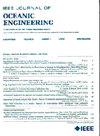微型自主水下航行器的单程行程混合基线导航
IF 3.8
2区 工程技术
Q1 ENGINEERING, CIVIL
引用次数: 0
摘要
准确可靠的导航是自主水下航行器(auv)执行任务和确保其安全的前提。传统的水下导航方案体积庞大、价格昂贵、耗电大,增加了水下航行器的尺寸和成本,阻碍了水下航行器的大众化,尤其是在水下航行器小型化和群体应用的趋势下。本文介绍了一种低成本、节能且可部署的微型auv导航方法。该方法被认为是单向行程时间混合基线(OWTT-HBL)导航,声学上由两个声信标组成,形成短基线(SBL)和AUV上的被动反向超SBL (piUSBL)接收阵列。信号广播和采集同时由机载同步时钟触发用于OWTT消息传递。安装在auv上的piUSBL接收阵列通过匹配滤波和阵列波束形成来确定SBL信标的倾斜范围和方向。推导了一种扩展卡尔曼滤波(EKF)状态估计器,融合了来自微机电系统惯性测量单元的声距角测量和航向角速率,提供了水下航行器的坐标和航向角。将微型AUV的一系列现场实验与差分gps记录的地面真实值和长基线系统进行了比较,证明了其导航能力。现场结果表明,OWTT-HBL具有与现有方法相当的精度,同时显示了微型AUV导航和多AUV系统的巨大潜力。本文章由计算机程序翻译,如有差异,请以英文原文为准。
One-Way-Travel-Time Hybrid Baseline Navigation for Micro Autonomous Underwater Vehicles
Accurate and reliable navigation is the prerequisite for autonomous underwater vehicles (AUVs) to perform tasks and ensure their safety. Conventional underwater navigation solutions are bulky, expensive, and power-hungry, increasing the AUV size and cost, which stifles the democratization of AUVs, especially for the trend of AUV miniaturization and swarm applications. This article presents a low-cost, power-efficient, and deployable approach to the navigation of micro AUVs. The approach, considered one-way travel-time hybrid baseline (OWTT-HBL) navigation, acoustically consists of two acoustic beacons forming a short baseline (SBL) and a passive inverted ultra-SBL (piUSBL) receiving array on the AUV. Signal broadcasting and acquisition are simultaneously triggered by onboard synchronized clocks for OWTT messaging. The AUV-mounted piUSBL receiving array determines the slant ranges and directions to the SBL beacons through matched filtering and array beamforming. An extended Kalman filter (EKF) state estimator is derived to fuse the acoustic range-angle measurements and the heading angular rate from a microelectromechanical system inertial measurement unit, providing the AUV coordinates and heading angles. A series of field experiments with a micro AUV were compared against the differential-GPS-recorded ground truth and a long baseline system, demonstrating the navigation capabilities. Field results show that the reported OWTT-HBL possesses an accuracy comparable to existing methods while showcasing the great potential for micro AUV navigation and multi-AUV systems.
求助全文
通过发布文献求助,成功后即可免费获取论文全文。
去求助
来源期刊

IEEE Journal of Oceanic Engineering
工程技术-工程:大洋
CiteScore
9.60
自引率
12.20%
发文量
86
审稿时长
12 months
期刊介绍:
The IEEE Journal of Oceanic Engineering (ISSN 0364-9059) is the online-only quarterly publication of the IEEE Oceanic Engineering Society (IEEE OES). The scope of the Journal is the field of interest of the IEEE OES, which encompasses all aspects of science, engineering, and technology that address research, development, and operations pertaining to all bodies of water. This includes the creation of new capabilities and technologies from concept design through prototypes, testing, and operational systems to sense, explore, understand, develop, use, and responsibly manage natural resources.
 求助内容:
求助内容: 应助结果提醒方式:
应助结果提醒方式:


